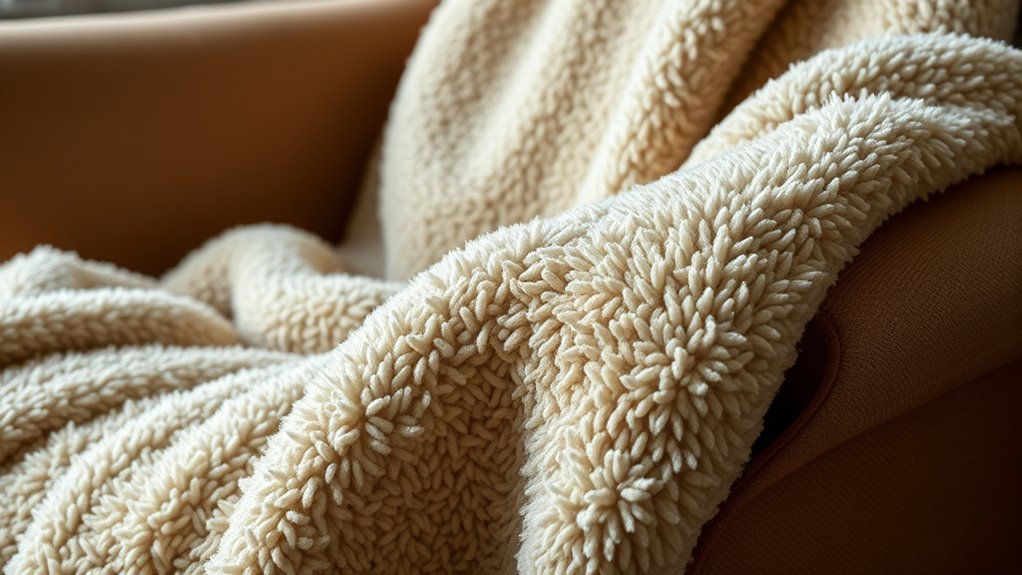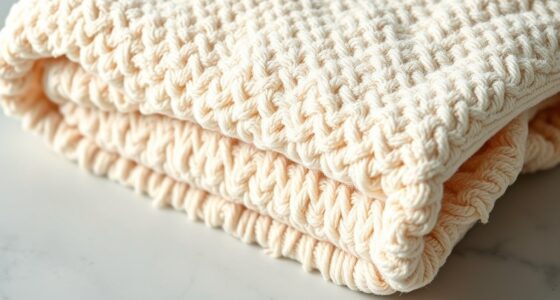Fuzzy blankets offer more than warmth—they provide a reassuring tactile experience that comforts your nervous system and eases emotional stress. The soft textures activate your sensory processing, making you feel safe and relaxed. When you wrap yourself in plush fibers, it signals your brain to calm down and regulate emotions. This natural comfort mechanism helps boost your emotional resilience. If you want to discover more about how textures influence your well-being, keep exploring this fascinating connection.
Key Takeaways
- Soft textures like fuzzy blankets evoke feelings of safety, relaxation, and emotional comfort, positively influencing mood and well-being.
- Tactile input from plush fibers activates sensory processing, helping to reduce anxiety and promote emotional regulation.
- Engaging with fuzzy textures provides predictable sensory stimuli that soothe the nervous system during stress or overload.
- The subconscious preference for soft textures acts as an instinctive self-care mechanism to foster emotional resilience.
- Overall, fuzzy blankets offer psychological benefits beyond warmth, supporting mental calmness and stability through tactile comfort.

Have you ever noticed how the texture of a fabric can instantly influence your sense of comfort? It’s more than just a visual appeal—your skin’s interaction with different surfaces can remarkably affect your mood and overall sense of well-being. When you wrap yourself in a fuzzy blanket, you’re engaging in a sensory experience that goes beyond warmth. Your sensory processing system responds to the soft, plush fibers, creating a soothing effect that can calm your mind and body. This tactile comfort isn’t accidental; it’s rooted in how our brains interpret textures and how those textures influence our emotional regulation.
Fuzzy blankets, with their gentle touch, activate your sensory receptors in a way that triggers feelings of safety and relaxation. For many, these textures evoke a sense of nostalgia or security, helping to reduce feelings of anxiety or stress. When your sensory processing is overwhelmed—say, during a stressful day—the comforting texture of a fuzzy blanket can serve as a tactile anchor, grounding you in the present moment. This isn’t just about feeling cozy; it’s about the way tactile input can regulate your emotional state. The act of wrapping yourself in something soft and warm helps to signal to your brain that it’s okay to relax, to let go of tension, and to feel safe.
The connection between texture and emotional regulation is powerful. Soft textures like fleece or plush fibers provide a gentle, consistent sensory input that can dampen hyperactivity in your nervous system. This calming effect can be especially beneficial if you experience sensory overload or heightened emotional responses. The sensation of a fuzzy blanket offers predictable, comforting input that helps balance your emotional responses, making it easier to cope with stress. In this way, your choice of textures becomes a tool for managing emotions—turning a simple act of wrapping up into a deliberate form of self-care. Additionally, the popularity of fuzzy blankets is supported by their ability to provide emotional comfort, which is essential for mental well-being.
In essence, the love for fuzzy blankets isn’t just about warmth; it’s about the emotional and sensory benefits they provide. They help regulate your nervous system, soothe your mind, and create a haven of comfort. When you seek out textures that nurture your senses, you’re engaging in a subconscious effort to enhance your emotional resilience. So next time you reach for that fuzzy blanket, know that it’s doing more than keeping you warm—it’s actively supporting your emotional well-being through the power of texture.
Frequently Asked Questions
How Do Fuzzy Blankets Affect Sleep Quality?
Fuzzy blankets can improve your sleep quality by providing sensory stimulation that promotes relaxation. Their soft texture offers comfort, helping you feel safe and secure, while thermal insulation keeps you warm without overheating. This cozy feeling reduces stress and encourages deeper sleep. When you use a fuzzy blanket, you create a calming environment that signals your body it’s time to rest, making it easier to fall asleep and stay asleep throughout the night.
Are Fuzzy Blankets Suitable for All Skin Types?
Imagine someone with sensitive skin trying a fuzzy blanket for the first time. While many find it cozy, if you have skin sensitivity or allergy concerns, it’s best to choose hypoallergenic materials. Fuzzy blankets aren’t suitable for all skin types, especially if you’re prone to irritation. Always check the label, test a small area first, and consult with a dermatologist if you’re unsure.
Can Fuzzy Textures Help Reduce Anxiety?
You might find fuzzy textures help reduce anxiety by supporting sensory integration and emotional regulation. When you touch something soft and comforting, it can soothe your nervous system and promote relaxation. These textures engage your senses in a calming way, helping you feel more grounded during stressful moments. Incorporating fuzzy blankets into your routine could provide a simple, effective tool to manage anxiety and enhance overall emotional well-being.
Do Fuzzy Blankets Have Any Health Benefits?
Imagine wrapping yourself in a soft, fuzzy blanket—it’s more than comfort; it’s sensory therapy. These blankets can promote emotional regulation, helping you manage stress and anxiety. While they may not cure health issues, they offer calming effects that support mental well-being. Using fuzzy blankets regularly can enhance relaxation, potentially lowering blood pressure and improving sleep quality, making them a simple yet effective tool for health benefits.
How Should I Wash and Care for Fuzzy Blankets?
To keep your fuzzy blankets soft and cozy, follow proper fabric maintenance and washing tips. Always check the care label for specific instructions. Usually, you should wash them in cold water on a gentle cycle with mild detergent, avoiding bleach. To prevent pilling, air dry or tumble dry on low heat. Regular care helps maintain their texture and extends the life of your fuzzy blanket, ensuring continuous comfort.
Conclusion
Imagine wrapping yourself in a fuzzy blanket like a warm hug from a loved one. The softness and texture soothe your mind, creating a cozy cocoon that shields you from stress. It’s as if each fiber is a gentle whisper, calming your thoughts and grounding you in the present moment. When you seek comfort, remember that the tactile embrace of fuzzy textures is your personal sanctuary—a safe haven built one soft thread at a time.









